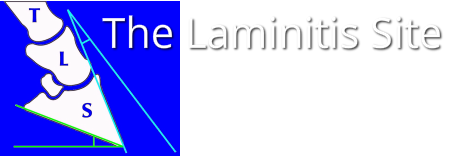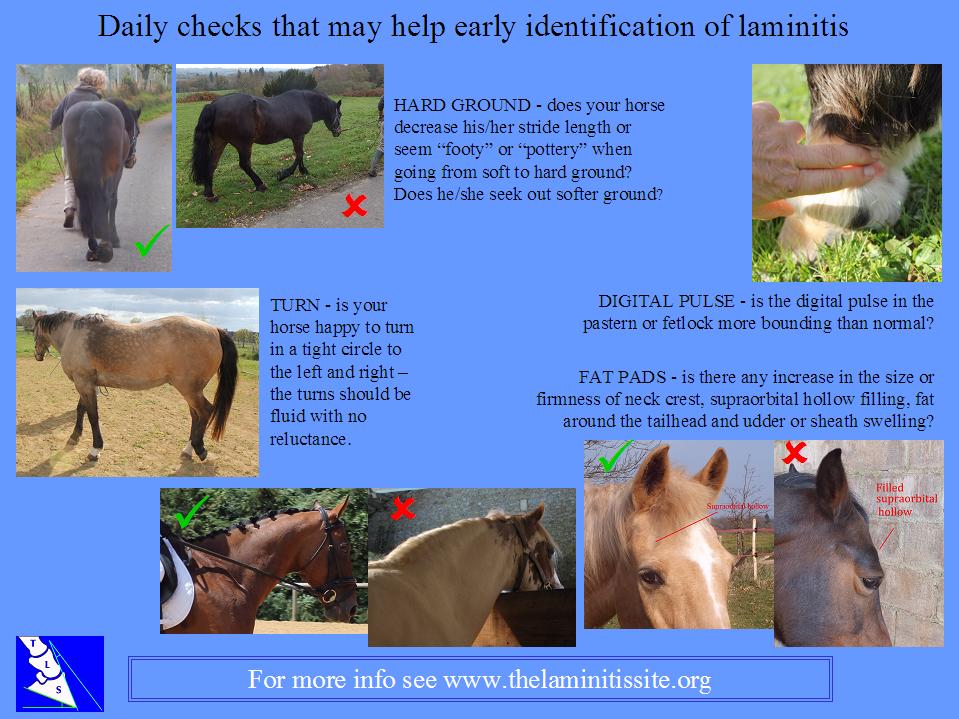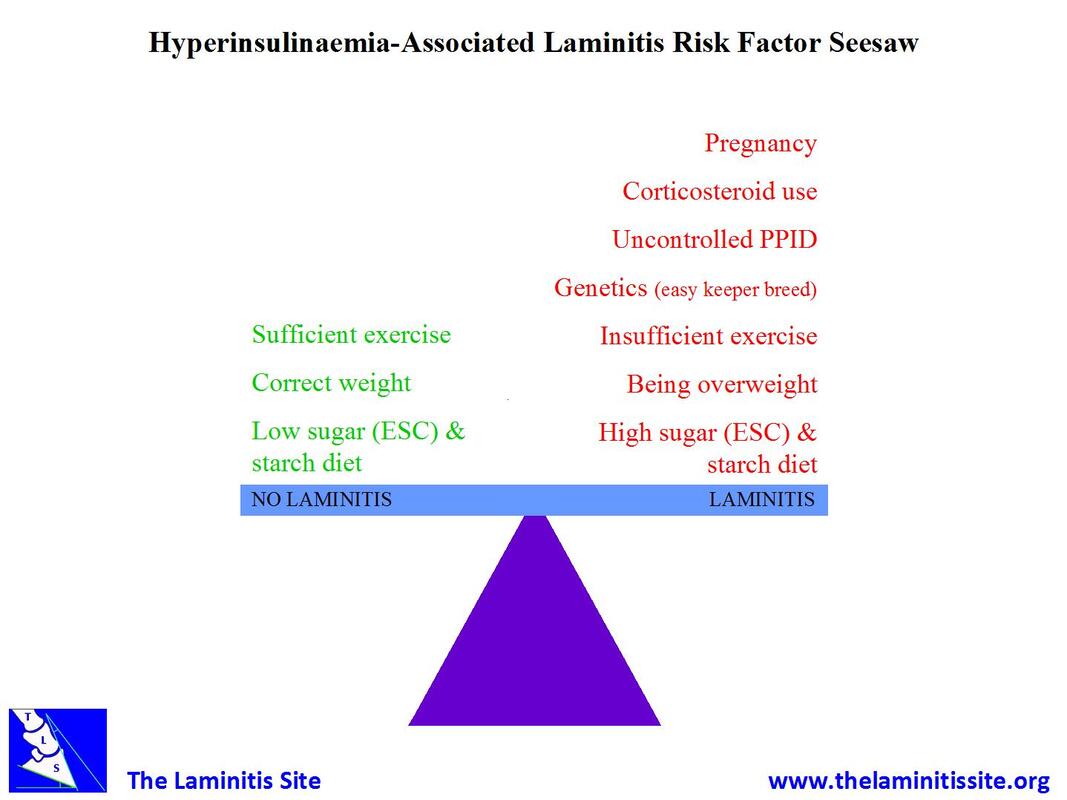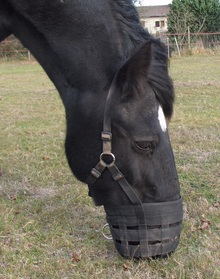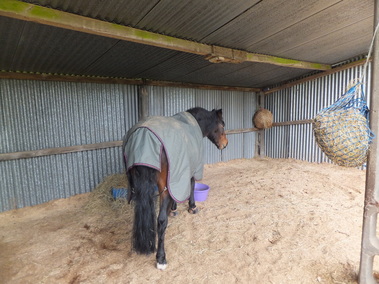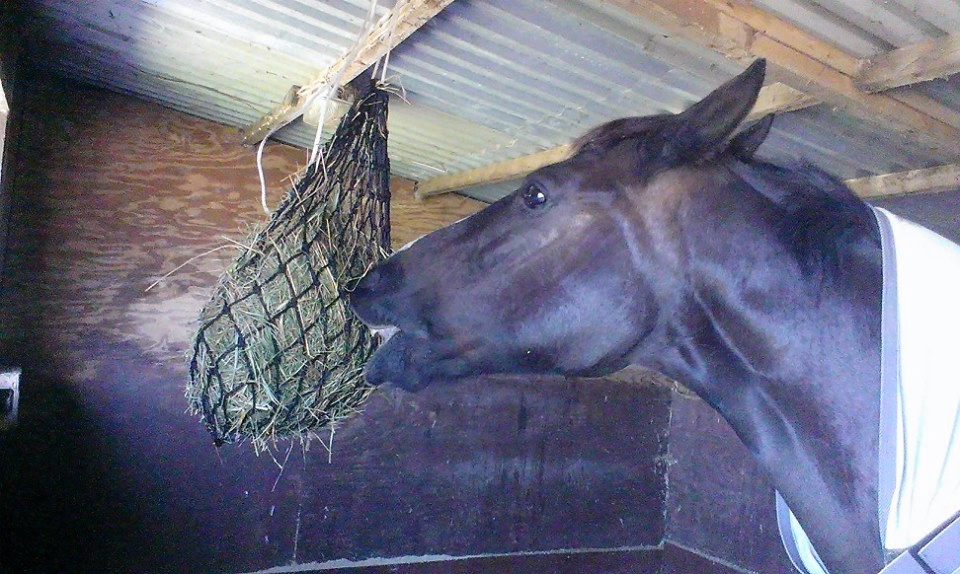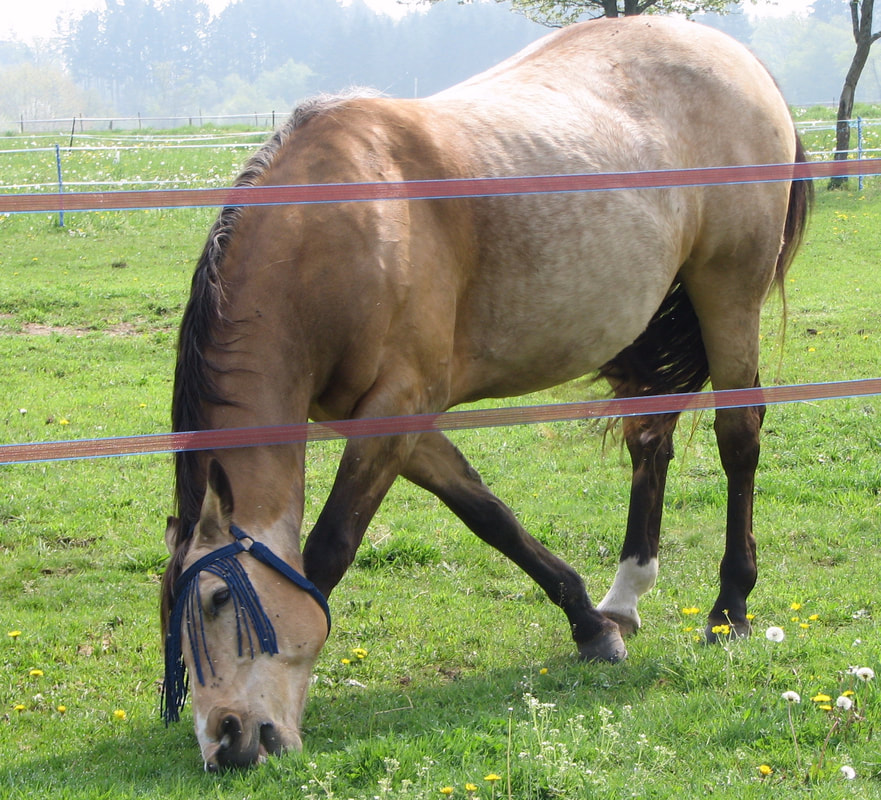Management Strategies for EMS/Insulin Dysregulation (ID)
Returning a previously laminitic/insulin dysregulated horse to grass
Strategies for reducing grass intake
Muzzles - grazing
Paddock/track systems
Strip grazing
Dry lots/bare paddocks
Feeding systems
Hay nets, slow feeders
Risks
Research
Strategies for reducing grass intake
Muzzles - grazing
Paddock/track systems
Strip grazing
Dry lots/bare paddocks
Feeding systems
Hay nets, slow feeders
Risks
Research
Returning a previously laminitic/insulin dysregulated horse to grass
While a horse is showing clinical signs of laminitis or has severe insulin dysregulation (ID), he/she should not have access to grass (or only very limited grass if a grass-free area is not available).
Once clinical signs of laminitis have resolved and insulin dysregulation and the factors that contributed to the laminitis are controlled, many horses should be able to return to some grazing.
1. Before considering a return to grazing checklist:
While a horse is showing clinical signs of laminitis or has severe insulin dysregulation (ID), he/she should not have access to grass (or only very limited grass if a grass-free area is not available).
Once clinical signs of laminitis have resolved and insulin dysregulation and the factors that contributed to the laminitis are controlled, many horses should be able to return to some grazing.
1. Before considering a return to grazing checklist:
- the horse is no longer considered actively laminitic and clinical signs of laminitis have resolved;
- baseline insulin levels are within normal ranges after eating his/her usual forage (hay/haylage/straw);
- any rotation has been fully corrected (i.e. the palmar/plantar angles are between 3 and 8 degrees, the toe wall is parallel to the dorsal surface of P3, breakover at the toe is at or just to the outside of the true white line, the feet look like normal healthy feet) - ideally confirmed by LM x-rays, and the feet well supported/protected if necessary e.g. with boots and pads;
- any excess weight has been lost, with the horse having a body condition score of 5/9 (Henneke scale) or close to this;
- the diet is low in sugar and starch (combined sugar/ESC and starch combined should be <10% on a dry matter basis), and providing essential protein, minerals, vitamins and fatty acids (feeding a low sugar/starch balancer such as Spillers Lite + Lean plus salt in addition to forage will usually be adequate);
- PPID is controlled (if diagnosed and thought to be contributing to insulin dysregulation, taking into account blood ACTH levels and/or clinical signs),
- ideally the horse is having some exercise (assuming the horse is sound and feet correctly aligned and supported/protected as required),
- the horse is not being given/has not recently been given corticosteroids.
2. Then it's all about insulin levels
Once everything on the return to grazing checklist is in place, particularly that the horse has a normal baseline insulin concentration after eating his/her usual hay/haylage/straw, there are 2 options:
A. Before allowing any access to grass, carry out an oral sugar test giving Karo Light corn syrup – if the result is normal, particularly if using the higher amount of Karo Light (0.45 ml/kg bodyweight), introduce the horse to grass and gradually increase the time spent grazing.
B. Introduce restricted grazing and gradually increase the time spent grazing to 1 to 2 hours, then test baseline insulin 1 hour after coming off the grass. This will give an idea of the horse’s actual insulin response to the grass he/she has eaten before the blood draw; however because sugar levels fluctuate significantly in grass through the day and by season, a normal insulin result on one day might not reflect the insulin result after the same time grazing on another day, so in terms of forecasting possible blood insulin levels this might not be such a useful test.
Once everything on the return to grazing checklist is in place, particularly that the horse has a normal baseline insulin concentration after eating his/her usual hay/haylage/straw, there are 2 options:
A. Before allowing any access to grass, carry out an oral sugar test giving Karo Light corn syrup – if the result is normal, particularly if using the higher amount of Karo Light (0.45 ml/kg bodyweight), introduce the horse to grass and gradually increase the time spent grazing.
B. Introduce restricted grazing and gradually increase the time spent grazing to 1 to 2 hours, then test baseline insulin 1 hour after coming off the grass. This will give an idea of the horse’s actual insulin response to the grass he/she has eaten before the blood draw; however because sugar levels fluctuate significantly in grass through the day and by season, a normal insulin result on one day might not reflect the insulin result after the same time grazing on another day, so in terms of forecasting possible blood insulin levels this might not be such a useful test.
3. Monitor closely
Once a previously laminitic/insulin dysregulated horse returns to grazing, monitor him/her closely for signs of increased insulin dysregulation or laminitis risk, particularly:
Monitor insulin levels as frequently as possible, with either the oral sugar test or testing baseline insulin after the horse has been eating grass.
Once a previously laminitic/insulin dysregulated horse returns to grazing, monitor him/her closely for signs of increased insulin dysregulation or laminitis risk, particularly:
- weight gain - check weight weekly with a tape, calculation or weighbridge, and body condition score every two weeks,
- appearance or increase in the size or firmness of fat pads - neck crest, filling of the supraorbital hollows, fat pads around the top of the tail, swelling around the sheath or udder,
- increased boundingness of digital pulse (but note that exercise, excitement, hard ground, heat and other foot problems may increase the strength of the pulse) - see Digital pulse,
- signs of foot discomfort, e.g. seeking soft ground, reducing stride length, being "sticky" behind when turning a tight circle.
Monitor insulin levels as frequently as possible, with either the oral sugar test or testing baseline insulin after the horse has been eating grass.
Keeping a horse that has had pasture-associated AKA hyperinsulinaemia-associated AKA endocrinopathic laminitis free from future laminitis and insulin dysregulation is a case of balancing the risk factors. In the diagram below:
The red factors (risks) cause laminitis.
The green factors (benefits) prevent laminitis.
When the red factors > the green factors = risk of laminitis.
The more the green factors can be increased, the better the horse can cope with any red factors - if the seesaw remains balanced, laminitis can be prevented.
For example, a native pony with easy keeper genetics (red risk factor) that is not overweight (green) and is in medium to hard work (green) may be able to eat unrestricted grass (red risk factor if high sugar/volume) without any risk of ID or laminitis.
However, if that pony is injured and not able to exercise (red risk factor), his risk of ID and laminitis will increase if the green factors do not increase correspondingly, e.g. by reducing the sugar and starch and energy (to prevent weight gain) in his diet.
Strategies for limiting grass intake
|
Strategies for limiting grass intake (both the quantity of grass eaten and the amount of sugar in that grass) include:
Note that turning horses out to graze for a short time may not be an effective strategy for controlling sugar/starch and energy intake, as in research ponies limited to 3 hours grazing soon learned to eat a lot more grass than normal in that period. |
There are great ideas for reducing grazing, encouraging weight loss and enriching your horse's environment in the When the grass is greener guide from the University of Liverpool.
Read how other owners have benefited from using alternative grazing systems:
Furtado T, King M, Pinchbeck G
The Use of Alternative Grazing Systems in the UK compiled by Tamsin Furtado, Mollie King, Gina Pinchbeck, January 2021
Laminitis risk from grass is likely to be related to the amount of simple sugars eaten - the result of the amount of grass eaten x the amount of sugar in the grass, so
5 kg of 7% sugar grass = 350 g sugar
2.5 kg of 14% sugar grass = 350 g sugar
Eating a small amount of short, exposed to the sun, stressed and therefore high sugar grass could potentially have the same effect on insulin as eating a lot more long, shaded, non-stressed and therefore lower sugar grass.
If you look at your horse's field and think there's no grass on it, ask whether you see your horse eating.
If he/she is eating, there's grass!!
It can be very useful to monitor a small patch of grass that the horse can't get to, either fenced off or just outside the field - if this is long but the grass in the field is short, you can be pretty certain there is plenty of grass, and your horse is eating in - horses appear to be amazingly good at eating grass, it's probably what they are best at!
If you decide to let your formerly ID horse return to grazing, you may have to become a bit of a grass expert - you have to take responsibility for controlling his/her sugar intake. Safergrass run by Katy Watts is a good place to learn about managing grass and understanding the factors that influence sugar content (although be aware that it is now known that is it ESC (ethanol soluble carbohydrates)/simple sugars and starch in grass that affect insulin levels, and not fructans, so therefore not the whole of WSC (water soluble carbohydrate) or NSC (non-structural carbohydrate). It is possible that grass with high WSC and NSC could be safe for ID horses, as long as the ESC and starch are below 10% (or whatever that horse's limit is - horses with a stronger genetic tendency for ID or that still have weight to lose or aren't getting as much exercise as they need may require a lower threshold - say 8% total ESC and starch to keep their insulin within the normal range).
Very briefly, reduce access to grass:
in periods of rapid growth e.g. spring, after rain - increased quantity,
in periods of frost (sunny days, nights below 5'C) and drought - increased sugar,
Do not assume "weeds" are low in sugar.
More information in the webcast EMS and Ponies – Dr Nicholas Frank – 18 October 2011
University of Minnesota – My Horse University – Cummings School of Veterinary Medicine
(Full notes here).
Read how other owners have benefited from using alternative grazing systems:
Furtado T, King M, Pinchbeck G
The Use of Alternative Grazing Systems in the UK compiled by Tamsin Furtado, Mollie King, Gina Pinchbeck, January 2021
Laminitis risk from grass is likely to be related to the amount of simple sugars eaten - the result of the amount of grass eaten x the amount of sugar in the grass, so
5 kg of 7% sugar grass = 350 g sugar
2.5 kg of 14% sugar grass = 350 g sugar
Eating a small amount of short, exposed to the sun, stressed and therefore high sugar grass could potentially have the same effect on insulin as eating a lot more long, shaded, non-stressed and therefore lower sugar grass.
If you look at your horse's field and think there's no grass on it, ask whether you see your horse eating.
If he/she is eating, there's grass!!
It can be very useful to monitor a small patch of grass that the horse can't get to, either fenced off or just outside the field - if this is long but the grass in the field is short, you can be pretty certain there is plenty of grass, and your horse is eating in - horses appear to be amazingly good at eating grass, it's probably what they are best at!
If you decide to let your formerly ID horse return to grazing, you may have to become a bit of a grass expert - you have to take responsibility for controlling his/her sugar intake. Safergrass run by Katy Watts is a good place to learn about managing grass and understanding the factors that influence sugar content (although be aware that it is now known that is it ESC (ethanol soluble carbohydrates)/simple sugars and starch in grass that affect insulin levels, and not fructans, so therefore not the whole of WSC (water soluble carbohydrate) or NSC (non-structural carbohydrate). It is possible that grass with high WSC and NSC could be safe for ID horses, as long as the ESC and starch are below 10% (or whatever that horse's limit is - horses with a stronger genetic tendency for ID or that still have weight to lose or aren't getting as much exercise as they need may require a lower threshold - say 8% total ESC and starch to keep their insulin within the normal range).
Very briefly, reduce access to grass:
in periods of rapid growth e.g. spring, after rain - increased quantity,
in periods of frost (sunny days, nights below 5'C) and drought - increased sugar,
Do not assume "weeds" are low in sugar.
More information in the webcast EMS and Ponies – Dr Nicholas Frank – 18 October 2011
University of Minnesota – My Horse University – Cummings School of Veterinary Medicine
(Full notes here).
Dry lots/bare paddocks
During rehab from laminitis, horses with endocrine laminitis often benefit from turnout in a dry lot or bare paddock.
Here are some great ideas for dry lots from Daisy Haven Farm
Here are some great ideas for dry lots from Daisy Haven Farm
Feeding Systems
Hampson BA, de Laat MA, Monot J, Bailliu D, Pollitt CC
Adaption of horses to a novel dynamic feeding system: movement and behavioural responses
Equine Veterinary Journal Accepted October 2012
See also:
The effect of a novel dynamic feeding system on horse behavior and movement - Brian Hampson International Equine Science Meeting 2012
Kutzner-Mulligan J, Eisemann J, Siciliano P, Smith J, Hewitt K, Sharlette J, Pratt-Phillips S
The effect of different feed delivery methods on time to consume feed and the resulting changes in postprandial metabolite concentrations in horses
J Anim Sci. 2013 Aug;91(8):3772-9. doi: 10.2527/jas.2012-5727. Epub 2013 Jun 5
Batt-Latch gate release timer - used to open gates and deliver hay nets in the middle of the night. See Swedish Horse Feeder by Alexandra Wikner.
Adaption of horses to a novel dynamic feeding system: movement and behavioural responses
Equine Veterinary Journal Accepted October 2012
See also:
The effect of a novel dynamic feeding system on horse behavior and movement - Brian Hampson International Equine Science Meeting 2012
Kutzner-Mulligan J, Eisemann J, Siciliano P, Smith J, Hewitt K, Sharlette J, Pratt-Phillips S
The effect of different feed delivery methods on time to consume feed and the resulting changes in postprandial metabolite concentrations in horses
J Anim Sci. 2013 Aug;91(8):3772-9. doi: 10.2527/jas.2012-5727. Epub 2013 Jun 5
Batt-Latch gate release timer - used to open gates and deliver hay nets in the middle of the night. See Swedish Horse Feeder by Alexandra Wikner.
Hay nets, slow feedersTo slow hay consumption, try:
|
UK
Use haylage nets with small holes, e.g. Trickle Net NB Friends of The Laminitis Site can claim 10% off orders of Trickle Nets - the voucher code is given on joining. Join FoTLS here. Greedy Feeder haynet USA Nibble Nets Slow Down hay feeder/soaker Rest of world Slowfeed Hay Saver Net |
DeBoer M, Keener L, Layeux-Parks J, Schueller O, Johnson L, Martinson K
Effect of hay nets on horse bodyweight, body condition score, hay usage, and dental health in mature adult horses
JEVS published online 24 March 2024, 105051. https://doi.org/10.1016/j.jevs.2024.105051
Adult horses were fed ad lib round bale hay either covered with a haynet (4.45 cm openings) or not, for a year each treatment in a cross-over study. Horses eating ad lib hay through a haynet lost weight (average loss 23 kg) and had a reduction in body condition score, horses eating ad lib hay without a haynet gained weight (average gain 20 kg) and had an increase in body condition score. Blinded dental examinations and treatments were carried out before the trial and at the end of each year. No differences were found in incisor length, dental abnormalities and condition between horses eating hay through a haynet or without a haynet, suggesting that haynets do not impact dental health (when used for a year).
How to use slow feed hay nets for horses - Cynthia Cooper - Natural Horse World
Mayara Gomes Correa, Camilla Ferreira Rodrigues e Silva, Lucas Antunes Dias, Sérgio da Silva Rocha Junior, Freddy Rodrigues Thomes, Luiz Alberto do Lago, Armando de Mattos Carvalho, Rafael Resende Faleiros,
Welfare benefits after the implementation of slow-feeder hay bags for stabled horses,
Journal of Veterinary Behavior July-August 2020 Vol 38 pags 61-66, published online May 2020. https://doi.org/10.1016/j.jveb.2020.05.010.
Using a hay bag increased hay consumption time by 87%, decreased abnormal behaviours and coprophagia, and it was concluded that using a slow-feeder bag improved the welfare of stabled horses.
Research found that horses take longer to eat hay in smaller holed haynets - using a hay net with 3.2 cm holes meant horses took on average 6.5 hours to eat their ration, compared to 3.1 hours for presumably the same size ration when fed on the ground and 3.4 hours when using a large holed haynet.
Glunk EC, Hathaway MR, Weber WJ, Sheaffer CC, Martinson KL
The effect of hay net design on rate of forage consumption when feeding adult horses
Journal of Equine Veterinary Science published online 19 May 2014
Effect of hay nets on horse bodyweight, body condition score, hay usage, and dental health in mature adult horses
JEVS published online 24 March 2024, 105051. https://doi.org/10.1016/j.jevs.2024.105051
Adult horses were fed ad lib round bale hay either covered with a haynet (4.45 cm openings) or not, for a year each treatment in a cross-over study. Horses eating ad lib hay through a haynet lost weight (average loss 23 kg) and had a reduction in body condition score, horses eating ad lib hay without a haynet gained weight (average gain 20 kg) and had an increase in body condition score. Blinded dental examinations and treatments were carried out before the trial and at the end of each year. No differences were found in incisor length, dental abnormalities and condition between horses eating hay through a haynet or without a haynet, suggesting that haynets do not impact dental health (when used for a year).
How to use slow feed hay nets for horses - Cynthia Cooper - Natural Horse World
Mayara Gomes Correa, Camilla Ferreira Rodrigues e Silva, Lucas Antunes Dias, Sérgio da Silva Rocha Junior, Freddy Rodrigues Thomes, Luiz Alberto do Lago, Armando de Mattos Carvalho, Rafael Resende Faleiros,
Welfare benefits after the implementation of slow-feeder hay bags for stabled horses,
Journal of Veterinary Behavior July-August 2020 Vol 38 pags 61-66, published online May 2020. https://doi.org/10.1016/j.jveb.2020.05.010.
Using a hay bag increased hay consumption time by 87%, decreased abnormal behaviours and coprophagia, and it was concluded that using a slow-feeder bag improved the welfare of stabled horses.
Research found that horses take longer to eat hay in smaller holed haynets - using a hay net with 3.2 cm holes meant horses took on average 6.5 hours to eat their ration, compared to 3.1 hours for presumably the same size ration when fed on the ground and 3.4 hours when using a large holed haynet.
Glunk EC, Hathaway MR, Weber WJ, Sheaffer CC, Martinson KL
The effect of hay net design on rate of forage consumption when feeding adult horses
Journal of Equine Veterinary Science published online 19 May 2014
Paddock/track systems
Setting up a track around a field can work well if you have ID and non-ID horses that you want to keep together - the non-ID horses can spend time in the centre of the field where there is plenty of grass, and the ID horses can stay on the track. This way they can always see each other, and will still help exercise each other and possibly even still be able to mutually groom over the fence, but with limited grass for the ID horse.
There have been suggestions that putting horses on a track will increase the distance they move. Research by Jenna Farmer et al. found that horses moved similar distances whether they were on a narrow track around the outside of a 2 hectare field (5.41 kg/day), in a 2 hectare field (4.94 kg/day) or in a 12 hectare field (5.26 kg/day), and found that having horses on a track had a detrimental impact on the environment (loss of vegetative coverage and soil erosion). Horses on the track were fed 1.5% of their bodyweight in hay in 2 feedings and in 4 tubs spaced around the track to encourage movement. Horses in the fields were not given hay. However, horses on the track had only 1/10 of the acreage available to the horses in the 2 hectare field and 1/60 of the acreage available to the horses in the 12 acre field, but moved a similar amount (slightly but not significantly more), therefore being on a track did not reduce movement but did considerably limit access to pasture compared to being in an open field, and enabled a reasonably controlled amount of forage to be fed (a controlled amount of hay plus whatever the horses were able to find to eat on the track), suggesting that putting horses on a track could encourage weight loss without restricting voluntary exercise.
Farmer J, Costin K, Duberstein J, Callaway T, Abrams A, Wassel B, Toak K, Duberstein K
Environmental impacts and daily voluntary movement of horses housed in pasture tracks as compared to conventional pasture housing.
SSRN January 2024 http://dx.doi.org/10.2139/ssrn.4704692
www.paddockparadise.wikifoundry.com
Rockley Farm blog - tracks
There have been suggestions that putting horses on a track will increase the distance they move. Research by Jenna Farmer et al. found that horses moved similar distances whether they were on a narrow track around the outside of a 2 hectare field (5.41 kg/day), in a 2 hectare field (4.94 kg/day) or in a 12 hectare field (5.26 kg/day), and found that having horses on a track had a detrimental impact on the environment (loss of vegetative coverage and soil erosion). Horses on the track were fed 1.5% of their bodyweight in hay in 2 feedings and in 4 tubs spaced around the track to encourage movement. Horses in the fields were not given hay. However, horses on the track had only 1/10 of the acreage available to the horses in the 2 hectare field and 1/60 of the acreage available to the horses in the 12 acre field, but moved a similar amount (slightly but not significantly more), therefore being on a track did not reduce movement but did considerably limit access to pasture compared to being in an open field, and enabled a reasonably controlled amount of forage to be fed (a controlled amount of hay plus whatever the horses were able to find to eat on the track), suggesting that putting horses on a track could encourage weight loss without restricting voluntary exercise.
Farmer J, Costin K, Duberstein J, Callaway T, Abrams A, Wassel B, Toak K, Duberstein K
Environmental impacts and daily voluntary movement of horses housed in pasture tracks as compared to conventional pasture housing.
SSRN January 2024 http://dx.doi.org/10.2139/ssrn.4704692
www.paddockparadise.wikifoundry.com
Rockley Farm blog - tracks
|
Strip grazing
Strip grazing can help to limit grass intake. Some hints: 1. Use 2 fences - one in front of the horse, onto the new grass, and one a distance behind, so that grazed grass can rest and grow again (ready for the horses to return to it in a few weeks' time), and so that horses can't graze grass too low and damage grazing areas. This also keeps the area for collecting dung smaller. Make sure horses do have enough room to socialize, roll and move though - if possible attach the strip grazing area to a grass free area. However, note that research by Annette Longland found that ponies did not gain more weight if a back fence was not used when strip grazing*. 2. The best time to move the forward fence to give more grass is as early morning, before the sun increases sugars in the grass. On cloudy days this isn't so important, and during frosty conditions (sunny days and nights colder than 5'C) it's best not to give new grass at all, as sugar levels will remain high overnight. Remember, sun = sugar. 3. Keeping in mind point 2, it might be best to move the fence a small amount 2 or 3 times a day, rather than moving the fence by a larger amount once a day. Perhaps early in the morning and last thing at night. 4. Don't be tempted to move the fence more than you had planned. Horses are very good at gobbling down fresh grass then telling you they are starving! If you are restricting grass quite severely, provide hay so that you know they do have enough fibre to eat. 5. Use electric fencing, make sure it works and keep it on! A low strand may be needed to stop horses grazing under the fence, and a high strand for horses to stop them leaning over the fence. |
6. Can you combine strip grazing with a track system, so that horses always have access to a reasonably grass free track to encourage exercise, with small amounts of grass available around the track. Opening up small amounts of grass well spread out around the track encourages horses to move between the grassy areas, increasing exercise.
Research using strip grazing
Longland AC, Barfoot C, Harris PA.
Strip grazing: Changes in biomass, nutrient content and digestibility of temperate, midsummer pasture by strip-grazed or 'free'-grazing ponies, over 4 weeks.
J Equine Vet Sci. 2023 Oct 25:104957. doi: 10.1016/j.jevs.2023.104957. Epub ahead of print. PMID: 37890600.
*Longland, AC, Barfoot, C, Harris, PA
Strip-grazing: Reduces pony dry matter intakes and changes in bodyweight and morphometrics
Equine Vet J. 2021; 00: 1– 8. https://doi.org/10.1111/evj.13416
See also Can strip grazing really help to control your horse's weight - Bella Fricker, Spillers, 11 June 2021
Strip-grazing: Management Tool to Fight Obesity - KER, June 2021
Longland AC, Barfoot C, Harris PA.
Strip grazing: Changes in biomass, nutrient content and digestibility of temperate, midsummer pasture by strip-grazed or 'free'-grazing ponies, over 4 weeks.
J Equine Vet Sci. 2023 Oct 25:104957. doi: 10.1016/j.jevs.2023.104957. Epub ahead of print. PMID: 37890600.
*Longland, AC, Barfoot, C, Harris, PA
Strip-grazing: Reduces pony dry matter intakes and changes in bodyweight and morphometrics
Equine Vet J. 2021; 00: 1– 8. https://doi.org/10.1111/evj.13416
See also Can strip grazing really help to control your horse's weight - Bella Fricker, Spillers, 11 June 2021
Strip-grazing: Management Tool to Fight Obesity - KER, June 2021
Risks
There can be risks associated with using some slow feeder systems.
Abnormal tooth wear has been associated with use of grazing muzzles and/or starvation paddocks with very short grass. It is sometimes suggested that haynets may also adversely affect teeth, and haynets can put horses at risk of getting a foot caught, particularly if the horse is shod and if the haynet is not hung high enough. Slow feeder systems may cause frustration and anxiety and horses should be taught to use them if necessary, or start with a large holed haynet and make sure a horse understands how to use that before going to a small holed haynet, and perhaps pull a few strands of hay out to help get the horse started. It has also been suggested that some slow feeder systems may cause unnatural eating positions and lead to orthopaedic issues. Slow feeder systems like any equipment used around horses must be checked regularly for wear, breakages, sharp edges and anything that could injure the horse.
Horse Slow Feeder Safety - Christa Leste-Lasserre, thehorse.com April 2021
There can be risks associated with using some slow feeder systems.
Abnormal tooth wear has been associated with use of grazing muzzles and/or starvation paddocks with very short grass. It is sometimes suggested that haynets may also adversely affect teeth, and haynets can put horses at risk of getting a foot caught, particularly if the horse is shod and if the haynet is not hung high enough. Slow feeder systems may cause frustration and anxiety and horses should be taught to use them if necessary, or start with a large holed haynet and make sure a horse understands how to use that before going to a small holed haynet, and perhaps pull a few strands of hay out to help get the horse started. It has also been suggested that some slow feeder systems may cause unnatural eating positions and lead to orthopaedic issues. Slow feeder systems like any equipment used around horses must be checked regularly for wear, breakages, sharp edges and anything that could injure the horse.
Horse Slow Feeder Safety - Christa Leste-Lasserre, thehorse.com April 2021
Research
Cameron A, Longland A, Pfau T, Pinnegar S, Brackston I, Hockenhull J, Harris PA, Menzies-Gow NJ
The Effect of Strip Grazing on Physical Activity and Behavior in Ponies
Journal of Equine Veterinary Science Volume 110 March 2022, 103745, doi.org/10.1016/j.jevs.2021.103745.
Keywords: Strip Grazing, Activity, Pony, Behaviour
Longland AC, Barfoot C, Harris PA
Strip-grazing: Reduces pony dry matter intakes and changes in bodyweight and morphometrics
Equine Veterinary Journal January 2022 Vol 54 Issue 1. https://doi.org/10.1111/evj.13416
Cameron A, Longland A, Pfau T, Pinnegar S, Brackston I, Hockenhull J, Harris PA, Menzies-Gow NJ
The Effect of Strip Grazing on Physical Activity and Behavior in Ponies
Journal of Equine Veterinary Science Volume 110 March 2022, 103745, doi.org/10.1016/j.jevs.2021.103745.
Keywords: Strip Grazing, Activity, Pony, Behaviour
Longland AC, Barfoot C, Harris PA
Strip-grazing: Reduces pony dry matter intakes and changes in bodyweight and morphometrics
Equine Veterinary Journal January 2022 Vol 54 Issue 1. https://doi.org/10.1111/evj.13416
